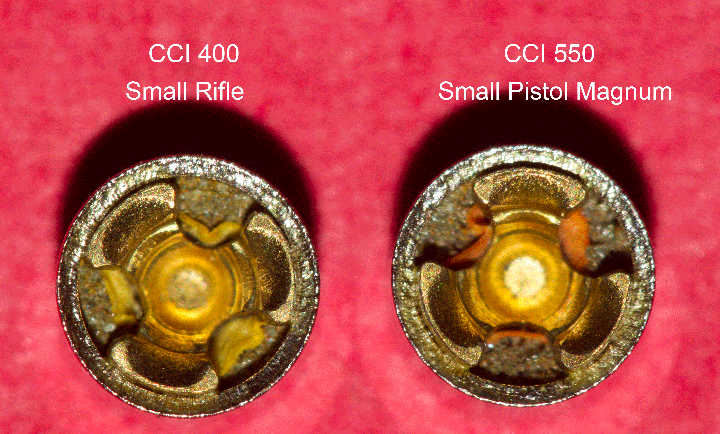I had resolved this issue before I ever posted. That's why my question was "What would YOU do" and not "What should I do".

First, small rifle primers have a similar type burn to small pistol magnum primers, but are made to withstand higher pressure. This is why powders like 296 that always recommend a MAGNUM pistol primer ignite just fine with small non-magnum rifle primers. Small Rifle Magnum primers burn a little hotter, and a little longer than standard Small Rifle or Magnum Small Pistol primers, made for the slower range of rifle powders used in small primer rifle rounds. Not really necessary for 296, but can't hurt, and was specified in my original load data some 25 years ago.
By the way, CCI Small Pistol Mag, and Small Rifle Mag primers are visually different (with magnifier

) as mentioned. Different color, slightly different anvil and 25gr of 296 under a 340gr bullet is hardly a light load in 454.
So, the biggest danger of firing these was a pierced primer, which is hardly an end of the world scenario. Maybe problematic if shot continuously.
Large rifle and pistol primers have different dimensions. Also, a simple matter of physics and support structure, a larger primer will pierce easier than a small primer of the same material, so the mentions of them doing so do not surprise me. Had this been a 30-06, I'd have been a lot more concerned about a complete firing pin sized hole, and not the smoky pinhole I'd expect from a small primer. It is a lot more common to find small pistol primers employed in a few small rifle cartridges where loaders claim better accuracy with certain recipes on the upper pressure edges.
So what did I do?
If you said "just shoot them and watch carefully for pierced primers", we are like thinkers. Incidentally, they shot fine, with no issues You can not visually tell the difference between these spent rounds, and ones using the correct primer. Accuracy was not great, but it will take another loading with the Rifle primers to see if the primer was even a factor.
I've been loading for 30 years, 454 Casull for 25. This was not a matter of a messy work bench or primers left out, etc. I simply grabbed the "white box" out of habit without reading the label, as they bother look a lot alike. I took an orange marker and painted a stripes on the sides of the Small Pistol Magnum primers to prevent myself from this mistake in the future. (I also mark Hodgdon powders these days as well) My brain processes pictures more quickly than text.
Thanks for all who played! Sorry, no prizes other than hopefully learning something. I'm not at all implying that Small Pistol Primers are okay for rifle pressures are anticipated. I'm just saying there is no need to panic as they may still be within the crossover threshold, and even if they cross that threshold and you get pierced primers, it's hardly catastrophic to find out. Nothing wrong with sticking to instructions by the letter, unless you forget to think about why they give you those specific guidelines, and that the specified numbers do not indicate a cliff at which point a safe load turns into a dangerous failure. The neat thing about reloading is that there is incremental warnings between those two points.

